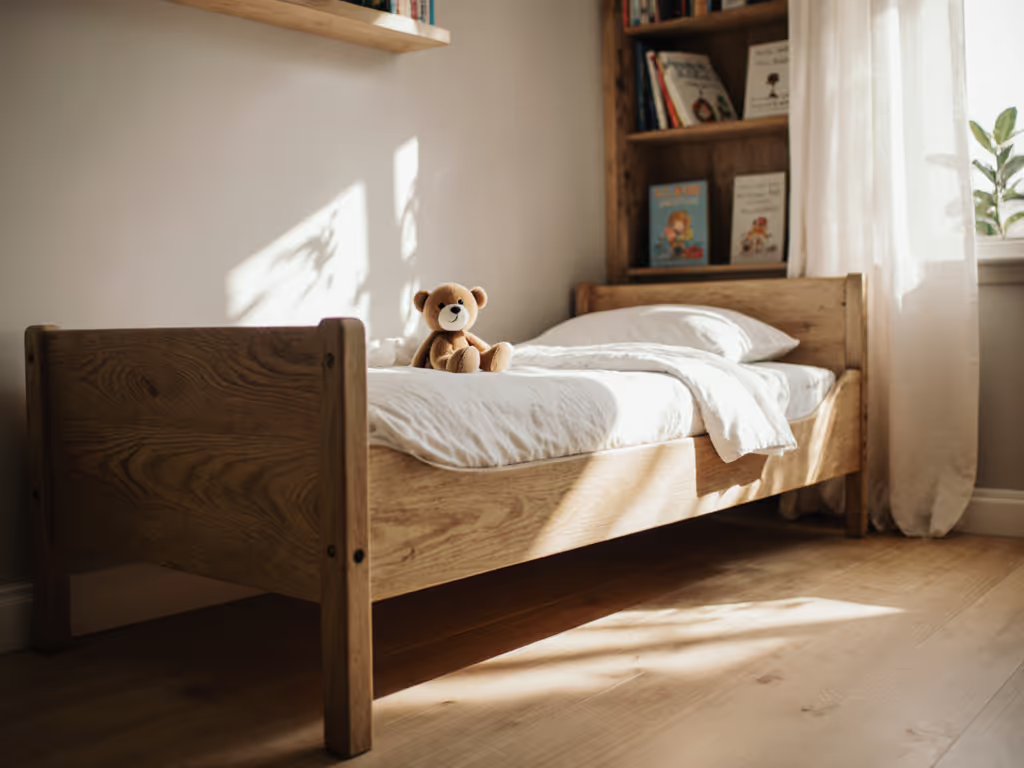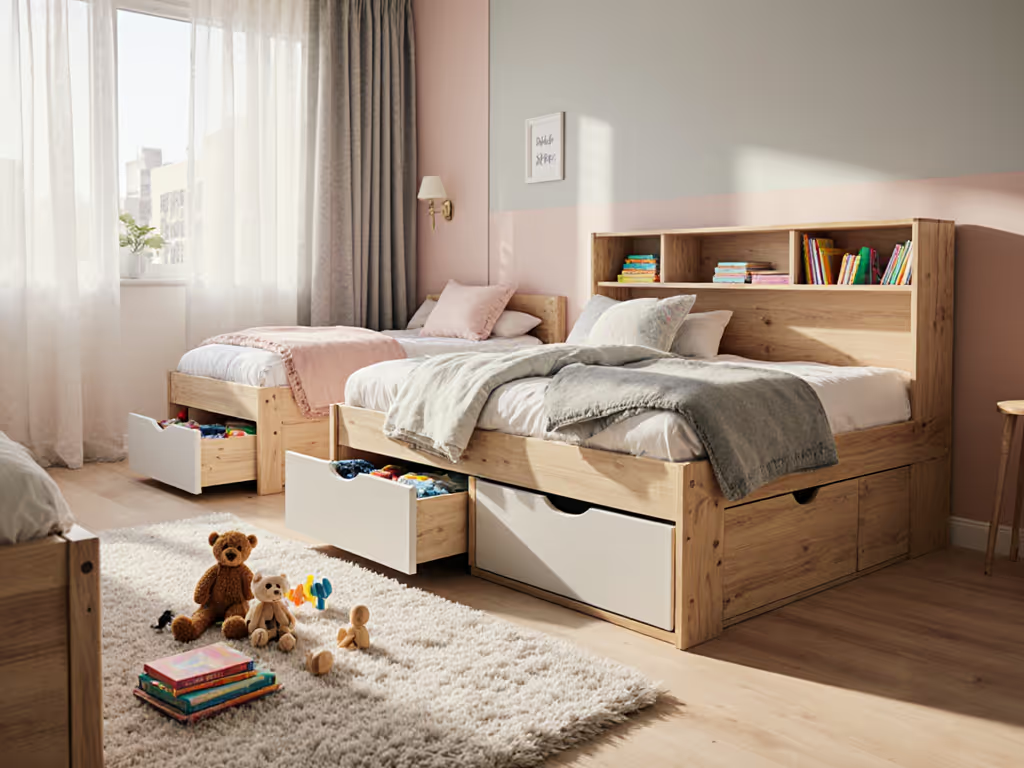
What Is a Floor Bed? Complete Parent Guide
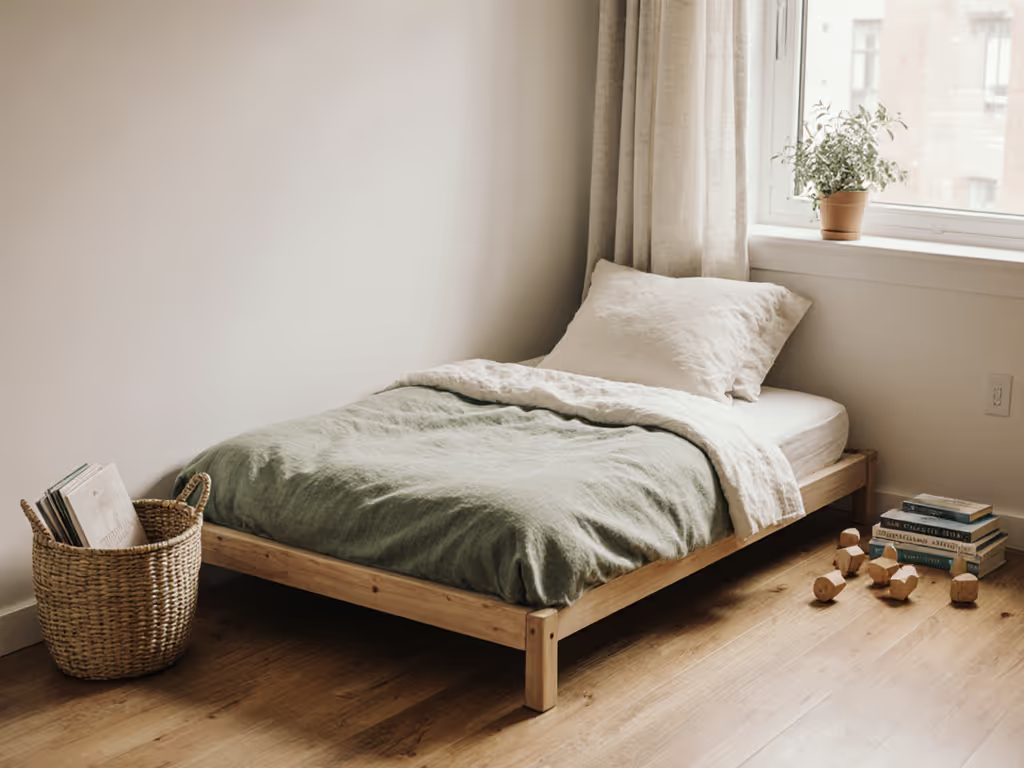
More than 70 percent of parents say their child's sleep quality shapes family well-being. Safe, restful sleep is a top priority, but the right environment makes all the difference. Floor beds remove physical barriers, offering toddlers the chance to move freely and become more independent. Discover how this simple shift can encourage healthy sleep, nurture confidence, and support both small-space living and toddler development.
Key Takeaways
| Point | Details |
|---|---|
| Floor Beds Promote Independence | Floor beds empower toddlers by allowing them to enter and exit their sleep space independently, supporting natural motor skill development and confidence. |
| Design Variability | Various floor bed designs, such as Montessori and minimalist options, cater to different developmental needs and spatial requirements, offering flexibility for families. |
| Safety Considerations | Floor beds significantly reduce fall risks by maintaining a low profile, but require thorough child-proofing measures and periodic safety inspections for optimal use. |
| Enhanced Developmental Benefits | By providing unrestricted movement and a child-centric environment, floor beds foster emotional, cognitive, and physical growth in young children. |
Defining Floor Beds for Toddlers
A floor bed represents a revolutionary sleeping solution for toddlers that transforms traditional bedroom setups by placing the mattress directly on the ground or within an ultra-low profile frame. Unlike standard cribs that elevate children 50-60cm above the floor, floor beds maintain a minimal height under 10cm, creating an entirely different sleep environment focused on independence and safe exploration.
These innovative sleeping spaces come in three primary design variations tailored to different family needs and child development stages. Montessori-style floor beds feature completely open sides, encouraging unrestricted movement and self-directed exploration. Minimalist platform designs offer subtle boundaries while maintaining an open concept, providing gentle spatial guidance for young children. Custom low beds can be specifically tailored to match your living space and your child's unique developmental requirements.
The core philosophy behind floor beds centers on promoting child autonomy and independent movement. By eliminating high railings and creating an accessible sleeping surface, these beds allow toddlers to enter and exit their sleep space independently, supporting natural motor skill development and building confidence. Parents appreciate how floor beds can seamlessly integrate into small apartments, shared rooms, or minimalist bedroom designs while supporting a child's growing sense of personal agency.
Key advantages of floor beds include:
- Unrestricted physical movement
- Enhanced motor skill development
- Easier transition from crib to independent sleeping
- Space-efficient design
- Promotes child's sense of independence
- Adaptable to various room configurations
Whether you're navigating a compact urban living space or seeking a more developmentally supportive sleep environment, floor beds offer a compelling alternative to traditional raised cribs. They represent more than just a sleeping surface - they're a thoughtful approach to childhood independence and spatial learning.
Types and Common Variations of Floor Beds
Floor beds aren't a one-size-fits-all solution but rather a diverse category of sleeping arrangements designed to support toddlers' developmental needs. Crib-Sized Floor Beds represent the most compact option, mirroring traditional crib dimensions but positioned directly on the ground. These beds provide a familiar sleeping environment while eliminating the height barrier of standard cribs, making them perfect for younger toddlers transitioning from infancy.
The Montessori Floor Bed collection offers more nuanced designs catering to different parental preferences and child safety requirements. Floor Beds With Rails provide a protective boundary to prevent nighttime rolling while maintaining an open, accessible design. These beds typically feature wooden side rails that create a subtle containment zone without feeling restrictive. Montessori House Bed Frames take a more imaginative approach, transforming the sleeping space into a whimsical wooden house-like structure that sparks a child's imagination while maintaining a low-profile sleeping surface.
For families with more space and older toddlers, Expandable Floor Bed Frames offer remarkable versatility. These designs can accommodate twin, double, or even larger mattress sizes, growing alongside your child's changing needs. Some models include modular elements that can be adjusted or removed as your toddler develops, providing long-term value and adaptability. The key is selecting a design that balances safety, independence, and developmental support.
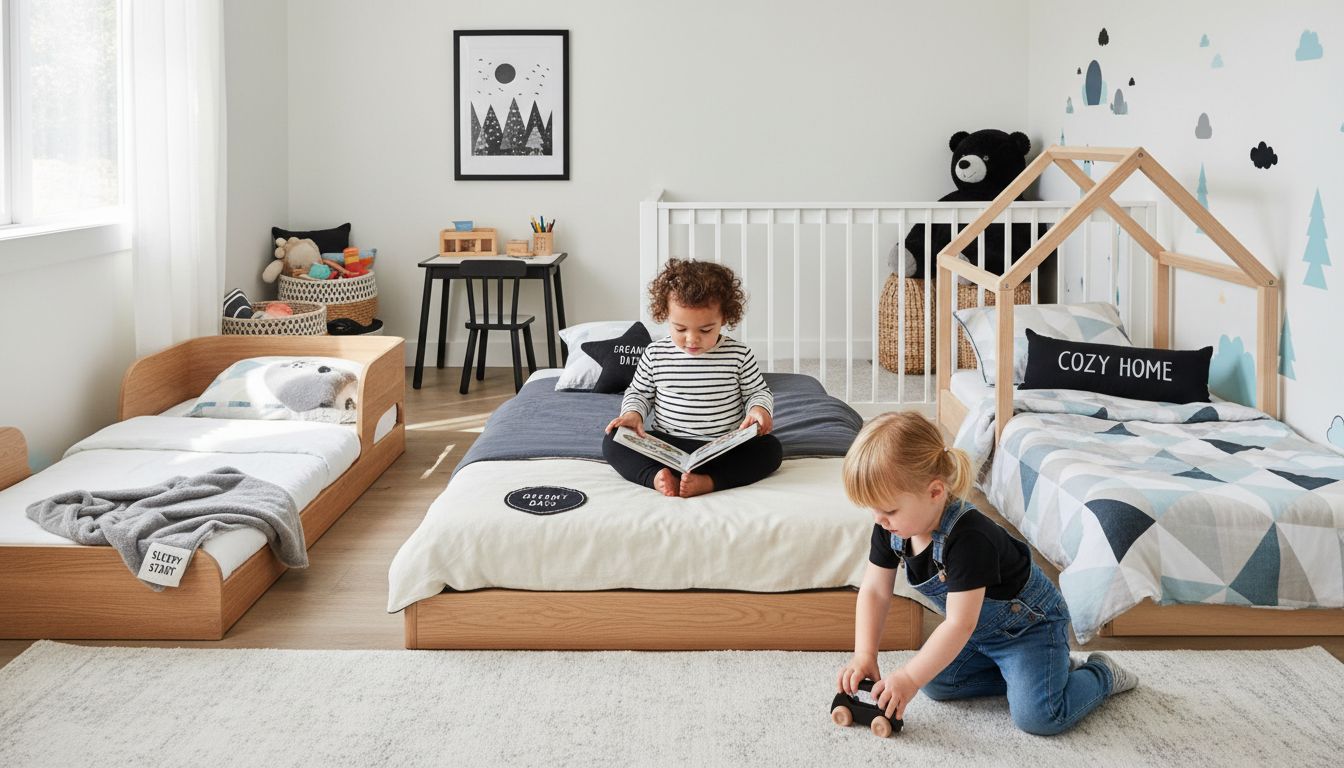
Common Floor Bed Variations Include:
Here's an overview of common floor bed types and their key features:
| Floor Bed Type | Design Features | Best For |
|---|---|---|
| Crib-Sized Floor Bed | Compact<br>Familiar dimensions | Younger toddlers |
| Montessori Bed with Rails | Open <br>Protective side rails | Transition from crib |
| House-Style Floor Bed | Whimsical frame<br>Low profile | Playful, imaginative kids |
| Minimalist Platform Bed | Simple frame<br>Low or no rails | Space-saving needs |
| Expandable Frame Bed | Adjustable size<br>Modular parts | Growing with child |
- Crib-Sized Floor Beds: Compact, familiar design
- Montessori Floor Beds with Rails: Protective yet open
- House-Style Floor Beds: Imaginative and playful
- Minimalist Platform Beds: Clean, simple design
- Expandable Frame Beds: Adaptable to child's growth
Choosing the right floor bed depends on your specific living space, your child's age, and your parenting philosophy. Whether you prefer a simple mattress on the floor or an intricately designed house-style frame, the goal remains consistent: creating a safe, independent sleeping environment that supports your toddler's natural development.
Benefits of Using a Floor Bed
Floor beds offer a transformative approach to childhood sleeping environments, delivering far more than just a place to rest. By positioning the sleeping surface at ground level, these innovative beds create a profound impact on a child's physical, cognitive, and emotional development. The most immediate benefit is enhanced physical independence, allowing toddlers to naturally explore their sleeping space without the constraints of high-sided cribs or restrictive barriers.
The safety advantages of floor beds cannot be overstated. Traditional raised cribs pose significant fall risks, with children potentially tumbling from heights of 50-60 centimeters. Floor beds dramatically reduce this danger by keeping the sleeping surface mere centimeters from the ground. This low-profile design not only minimizes injury risks but also empowers children to develop self-regulation skills. They learn to assess their own physical boundaries, understand movement limitations, and make independent choices about entering and exiting their sleep space.
Beyond physical safety, floor beds play a crucial role in supporting emotional and cognitive development. By providing an open, accessible sleeping environment, these beds encourage self-directed exploration and boost a child's confidence. Children develop a sense of agency and autonomy, learning to make decisions about their personal space. Parents frequently report increased self-esteem and problem-solving skills in children who use floor beds, as these sleeping arrangements inherently promote independence and self-discovery.
Key Benefits of Floor Beds:
- Reduced risk of falling injuries
- Enhanced motor skill development
- Promotes independent movement
- Supports cognitive and emotional growth
- Cost-effective and adaptable design
- Flexible for various room configurations
- Encourages self-directed learning
Ultimately, floor beds represent more than just a sleeping solution. They're a thoughtful approach to childhood development, balancing safety, independence, and the natural curiosity of growing toddlers. By creating an environment that respects a child's emerging capabilities, floor beds become a powerful tool in supporting holistic child development.
Safety Guidelines and Essential Setup Tips
Creating a safe floor bed environment goes far beyond simply placing a mattress on the ground. The foundation of floor bed safety starts with selecting the right mattress specifications. Experts recommend using a firm, entirely flat mattress that is both waterproof and breathable. The mattress should fit snugly within the bed frame or floor space, eliminating any gaps that could potentially trap a child or compromise their safety.
Child-proofing the entire sleeping area is critical when implementing a floor bed setup. Room preparation involves a comprehensive assessment of potential hazards within a child's reach. This means securing furniture, covering electrical outlets, anchoring potential tipping objects, and creating clear pathways around the sleeping space. Parents should conduct a thorough 360-degree inspection, getting down to their child's eye level to identify any potential risks that might not be immediately apparent from an adult perspective.
Regular maintenance and ongoing safety monitoring are essential components of floor bed management. Routine inspections should include checking the mattress for wear and tear, ensuring no loose threads or damaged areas could pose entrapment risks. The surrounding floor area must remain clear of small objects, loose rugs, or items that could cause tripping. Many pediatric experts recommend creating a dedicated sleep zone with minimal surrounding furniture, allowing safe and unrestricted movement while reducing potential accident risks.
Critical Safety Checklist for Floor Beds:
- Use a firm, breathable mattress
- Ensure mattress fits snugly in frame or floor space
- Remove potential choking hazards
- Anchor nearby furniture
- Cover electrical outlets
- Create clear movement pathways
- Conduct monthly safety inspections
- Maintain a clutter-free sleeping environment
Navigating floor bed safety requires consistent vigilance and proactive planning. By prioritizing your child's physical environment and maintaining a careful, attentive approach, you can create a sleeping space that supports independence while ensuring maximum protection.
Comparing Floor Beds to Toddler Beds
Bed height represents the most critical distinguishing factor between floor beds and traditional toddler beds. Traditional cribs stand at an imposing 50-60 centimeters high, essentially creating a containment zone that restricts a child's movement. Toddler beds occupy a middle ground, typically ranging 30-40 centimeters above the floor, offering a compromise between safety and independence. Floor beds, by contrast, maintain an ultra-low profile under 10 centimeters, revolutionizing the entire sleeping experience by prioritizing unrestricted movement and self-directed exploration.
The philosophical approach to child development differs dramatically between these bed types. Toddler beds represent a transitional solution, maintaining some of the containment principles of cribs while providing slightly more freedom. They often feature low side rails and are designed to use standard crib mattresses, making them a familiar choice for parents reluctant to completely abandon traditional sleeping arrangements. Floor beds, however, embrace a more radical Montessori-inspired approach, viewing the sleeping space as an opportunity for learning, independence, and natural motor skill development.
Each bed type presents unique advantages and considerations for parents. Toddler beds offer a gradual transition from cribs, with familiar design elements and built-in safety features like low side rails. They're typically more budget-friendly and can use existing crib mattresses. Floor beds excel in promoting independence, reducing fall risks, and supporting cognitive development through unrestricted movement. They require more intentional room design and child-proofing but provide a more holistic approach to a child's sleeping environment.
Key Comparison Points:
- Height: Floor beds (10cm), Toddler beds (30-40cm), Cribs (50-60cm)
- Movement Freedom: Floor beds (Maximum), Toddler beds (Moderate), Cribs (Minimal)
- Independence Support: Floor beds (High), Toddler beds (Moderate), Cribs (Low)
- Safety Approach: Floor beds (Open exploration), Toddler beds (Guided transition), Cribs (Maximum containment)
- Room Design Requirements: Floor beds (Extensive), Toddler beds (Moderate), Cribs (Minimal)
Ultimately, the choice between floor beds and toddler beds depends on your parenting philosophy, living space, and your child's individual developmental needs. Both options offer unique benefits, and the right choice varies for each family's unique circumstances.
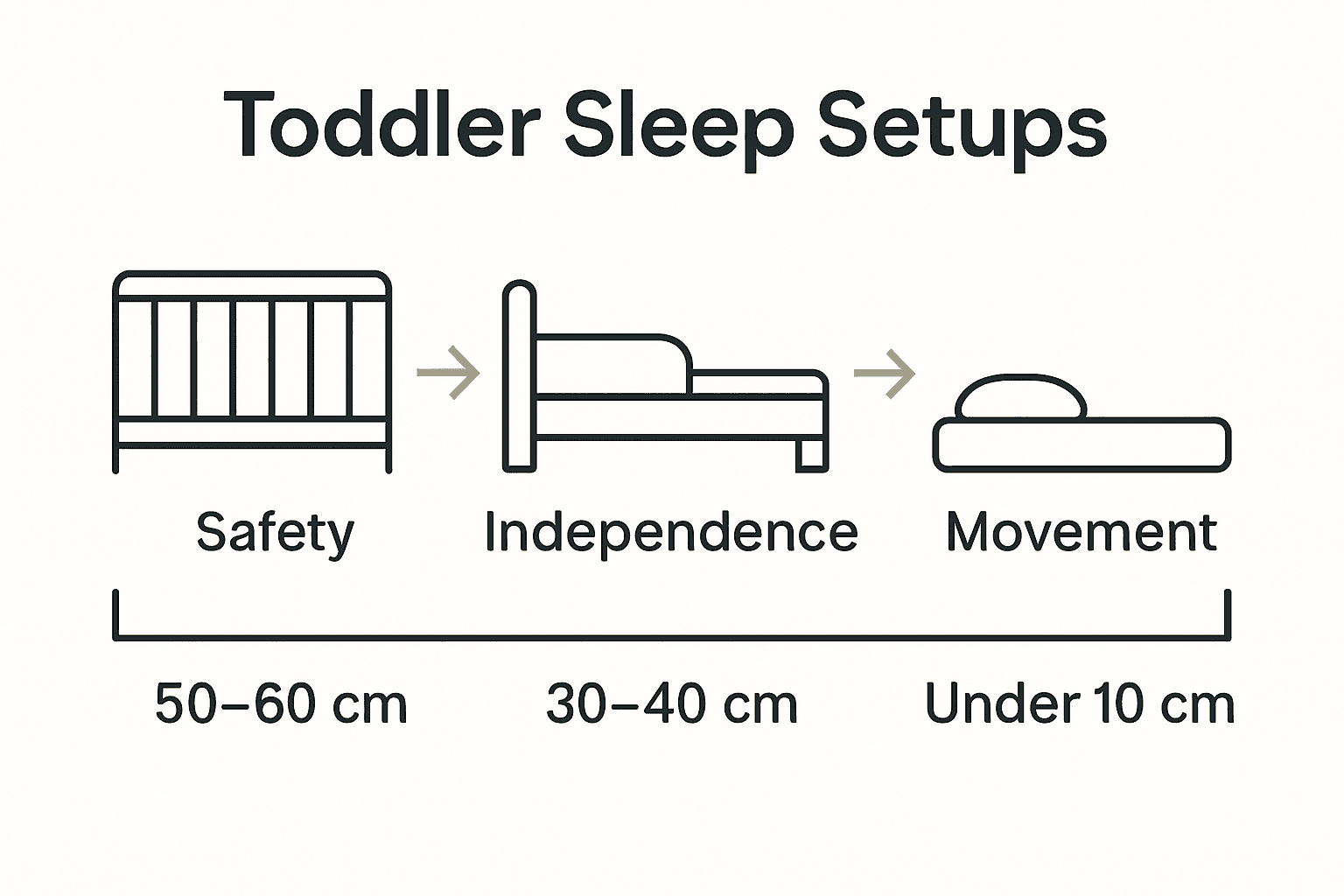
Discover the Perfect Floor Bed Solution for Your Toddler's Independence and Safety
Transitioning your toddler to a floor bed is a big step toward fostering confidence and safe exploration. If you are concerned about creating a safe, space-efficient sleeping environment that encourages your little one’s independence while reducing fall risks, you are not alone. Many parents face the challenge of balancing safety and freedom in their child's sleep space. This is where understanding the different types of floor beds and their benefits becomes essential.
At City Toddler Beds, we specialize in guiding parents through these decisions with expert advice, detailed comparisons, and practical safety tips. Whether you are curious about Montessori-inspired designs, expandable frame beds, or the minimalist platform options, you will find insights to help you choose the best bed to suit your toddler’s needs and your living space. Don't wait to create a nurturing environment that promotes growth, motor skills, and emotional development. Start exploring our resources at https://citytoddlerbeds.store and make the confident choice for your child’s first independent bed today.
Frequently Asked Questions
What is a floor bed for toddlers?
A floor bed is a sleeping arrangement that places a mattress directly on the ground or within a low-profile frame, allowing for independent movement and exploration for toddlers. It encourages child autonomy and supports natural motor skill development.
What are the advantages of using a floor bed instead of a traditional crib?
Floor beds provide several benefits, including reduced risk of falling injuries, enhanced motor skill development, better support for independent movement, and a more adaptable design for various room configurations, promoting a child's sense of independence.
How can I safely set up a floor bed for my toddler?
To ensure safety, use a firm, breathable mattress that fits snugly, child-proof the sleeping area, remove potential hazards, and keep the surrounding space clutter-free. Regular maintenance checks are also essential to provide a safe sleep environment.
What types of floor beds are available for toddlers?
Common types of floor beds include crib-sized floor beds, Montessori beds with or without rails, house-style beds, minimalist platform beds, and expandable frame beds. Each design caters to different child development stages and parental preferences.

